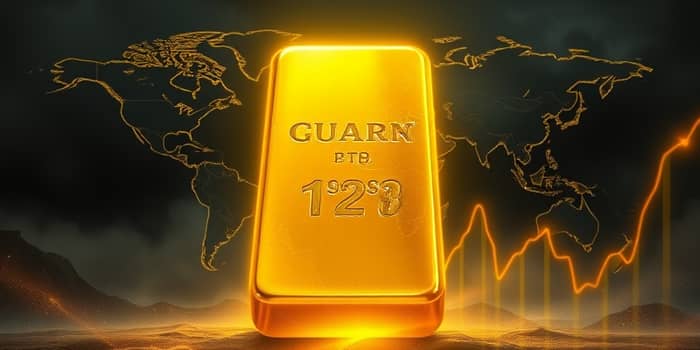
In 2025, gold has surged to unprecedented levels, capturing the attention of investors worldwide. With prices reaching new peaks, the precious metal has outperformed traditional assets and provided a haven amid global turmoil. This article delves deeply into the forces behind gold’s rally and offers a comprehensive outlook on where prices may head next.
Gold’s ascent to an all-time record high prices above $3,500 per ounce reflects mounting concerns over the world economy. Investors are grappling with persistent economic, political, and geopolitical uncertainties that have eroded confidence in conventional safe havens such as government bonds and even digital assets.
U.S. fiscal policy has become a focal point, with debates over tax reform and spending driving fears of higher deficits. The specter of ballooning U.S. government debt has reached a fever pitch, prompting credit rating worries and fueling demand for a tangible store of value. In tandem, global recession risks and potential stagflation scenarios have reinforced gold’s reputation as a reliable hedge against inflation and market volatility.
While gold has been on a stellar run, other traditional safe havens have struggled to keep pace. U.S. Treasuries, typically viewed as the benchmark risk-free asset, have seen muted inflows despite sky-high yields. The combination of a weak rally in bond markets and unusually high treasury yields above 4.5% on the 10-year has perplexed many analysts.
Cryptocurrencies, once heralded as “digital gold,” have also failed to deliver consistent stability. Bitcoin’s price movements have increasingly mirrored those of equities, undermining its status as a true haven. In contrast, gold’s performance has been largely insulated from equity swings, reaffirming its unique role in diversified portfolios.
The resurgence in gold demand is not confined to a single investor class. Exchange-traded funds (ETFs) have witnessed the most vigorous inflows since 2022, with Q1 2025 seeing record Q1 2025 inflows of 226 tonnes. These purchases highlight a growing institutional appetite for metal-backed vehicles that combine liquidity with direct exposure to gold.
Central banks have also maintained their status as key drivers of market dynamics. For the 16th consecutive year, they added net 244 tonnes of gold in Q1 2025, despite global economic headwinds. This strong commitment by monetary authorities underscores a strategic shift in reserve diversification away from fiat currencies.
At the retail level, bars and coins have experienced a surge, particularly in Asia. China recorded its second-highest quarterly demand on record, driven by cultural affinity and concerns over domestic financial stability. Retail investors in Europe and the Middle East are also increasingly turning to gold as a way to preserve wealth amid currency fluctuations.
Analysts are divided on where gold will settle by year-end, but consensus scenarios range from conservative to wildly optimistic. In a base-case, gold averages around $3,200-$3,300 per ounce, reflecting continued safe-haven demand tempered by periodic profit-taking.
In a bull-case, where stagflation intensifies or accelerating global de-dollarization risks become a central narrative, gold could challenge $4,000 per ounce. A sharp decoupling of emerging-market currencies from the dollar would send ripples through commodity markets, further solidifying gold’s role as an alternative reserve asset.
Conversely, a bear-case scenario hinges on a robust economic recovery and decisive monetary tightening that restores faith in paper currencies. Under such conditions, gold might correct below the $3,000 threshold, though many institutions now view $3,000 as a psychological floor.
Global political tensions remain an undercurrent supporting gold’s appeal. Trade disputes between the U.S. and China, instability in the Middle East, and European political fragmentation have all heightened risk aversion. These developments drive sovereign wealth funds and private investors toward safe assets.
Regionally, Asia continues to dominate gold consumption. India’s wedding and festival seasons historically boost demand, while China’s retail appetite signifies a broader trend of gold accumulation. Emerging markets in Africa and Latin America are also expanding their reserves, partly in response to concerns over currency devaluation.
Despite the robust rally, several headwinds could temper gold’s advance. A concerted effort by central banks to normalize interest rates could shore up the dollar, reducing the incentive to hold gold. Likewise, improvements in fiscal positions or breakthroughs in trade negotiations might alleviate some of the pressure that has buoyed prices.
However, the prevailing trend appears skewed toward higher prices, not lower. Top analysts at J.P. Morgan forecast an average of $3,675 per ounce by Q4 2025, noting that “risks are skewed toward an earlier overshoot” if current inflows persist. The World Gold Council and SSGA echo these sentiments, highlighting gold’s unique role in diversified portfolios under stress.
For investors, the key takeaway is to maintain a balanced approach. Gold should be viewed not as a speculative bet, but as a strategic allocation that can enhance resilience. By monitoring central bank policies, debt dynamics, and currency trends, one can navigate the evolving landscape with greater confidence.
Ultimately, gold’s recent performance has reaffirmed its status as the preeminent safe haven in times of turmoil. Whether used to hedge against inflation, currency devaluation, or geopolitical shocks, the metal’s intrinsic value and historical legacy make it a cornerstone of prudent investment strategies for 2025 and beyond.
References













